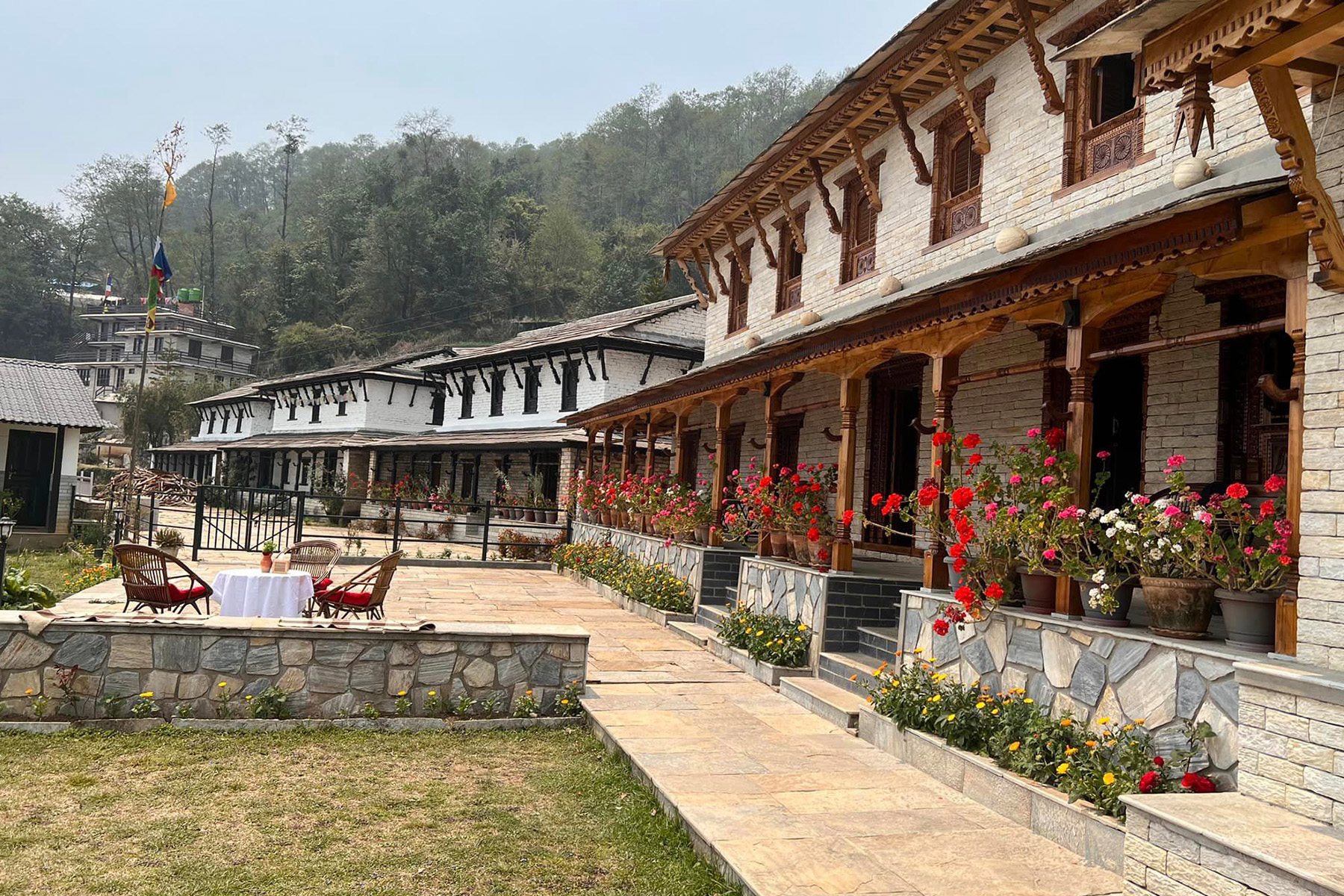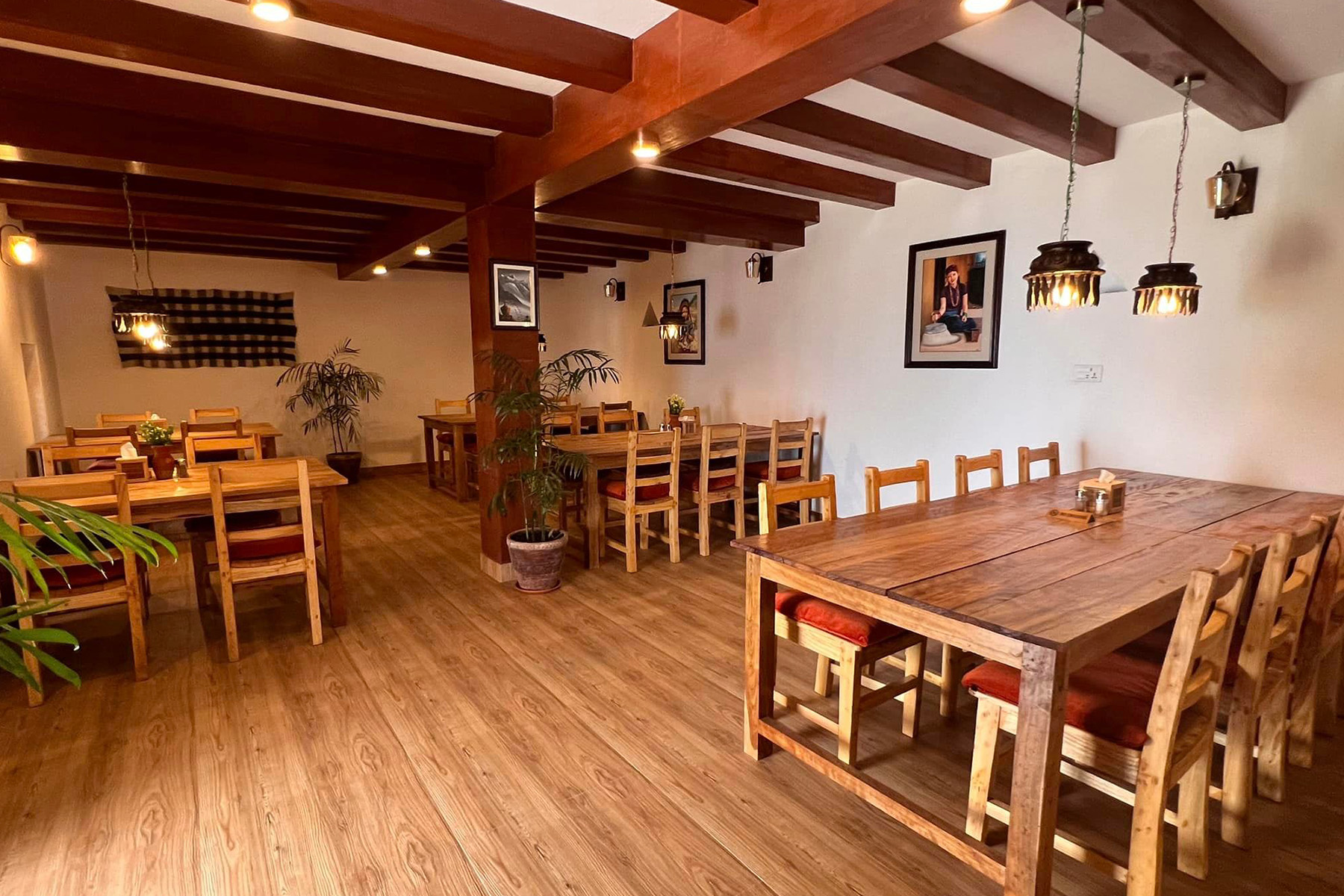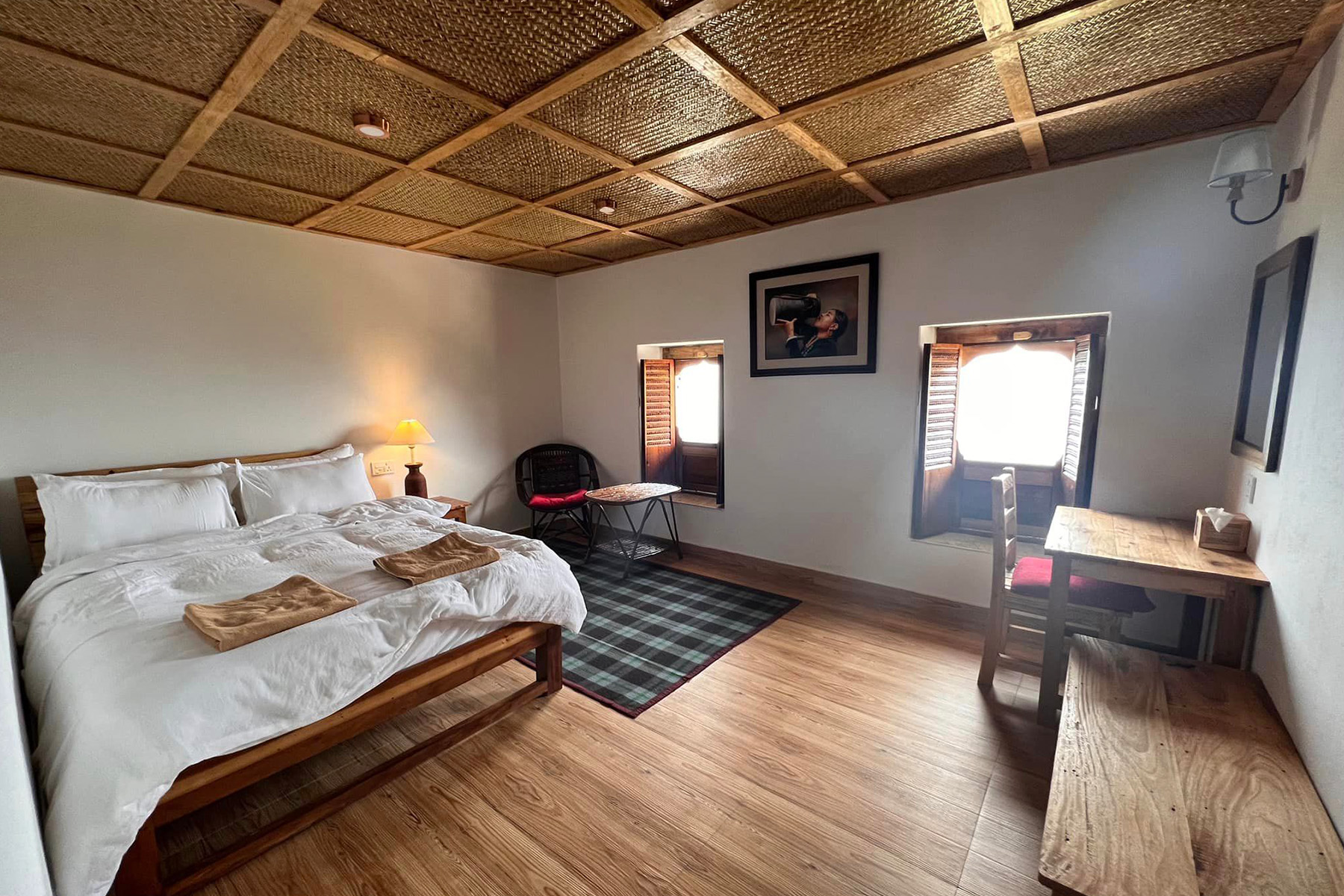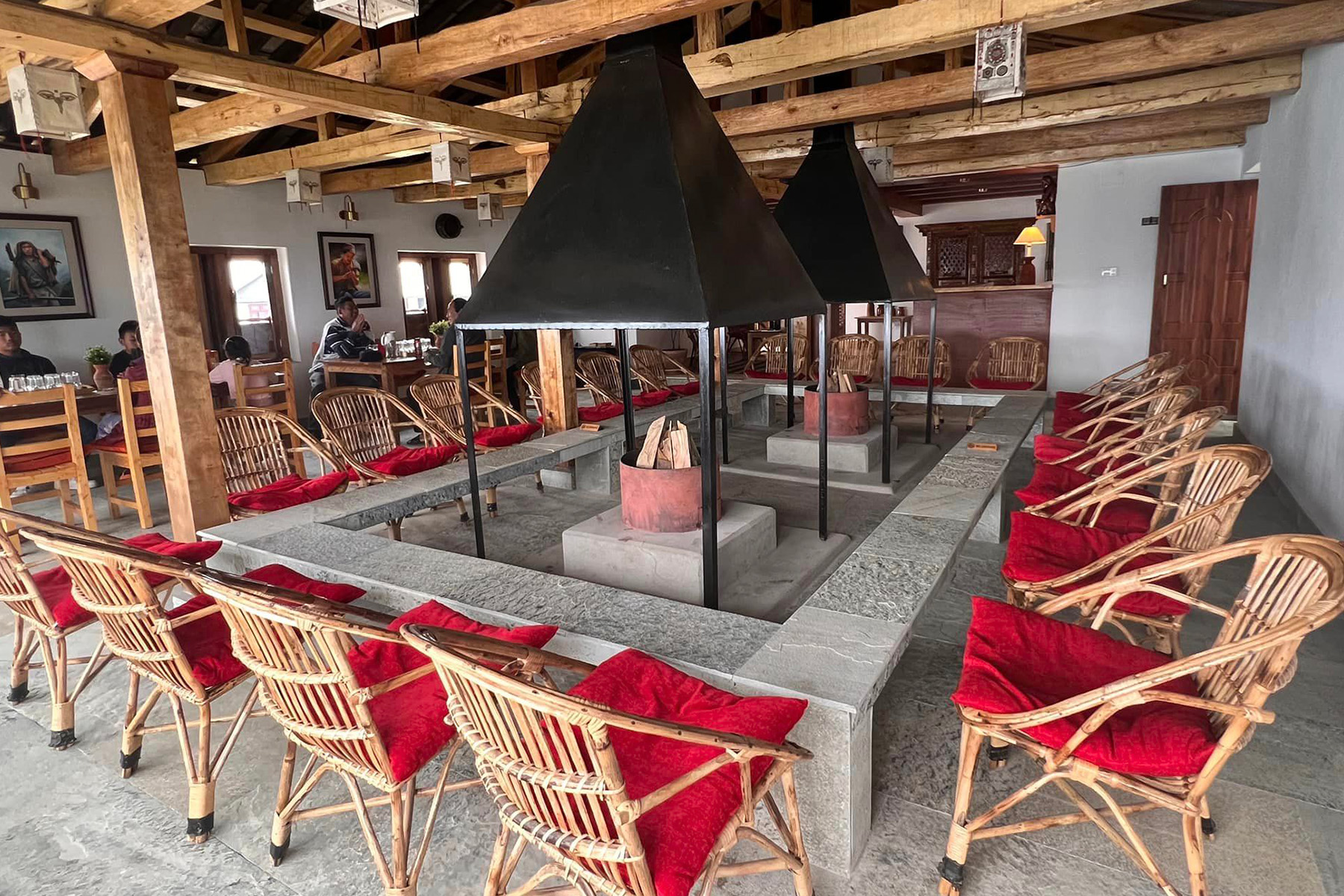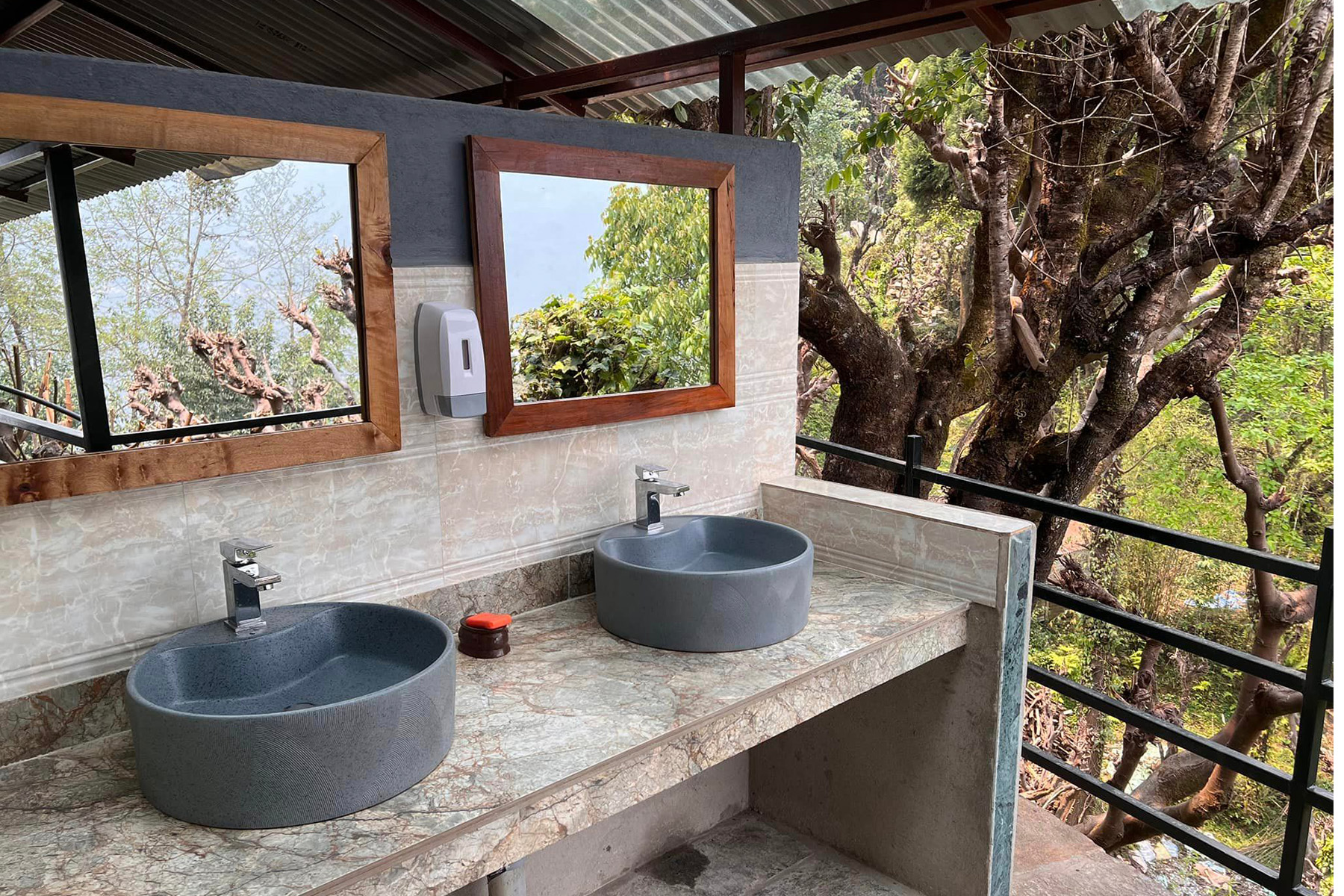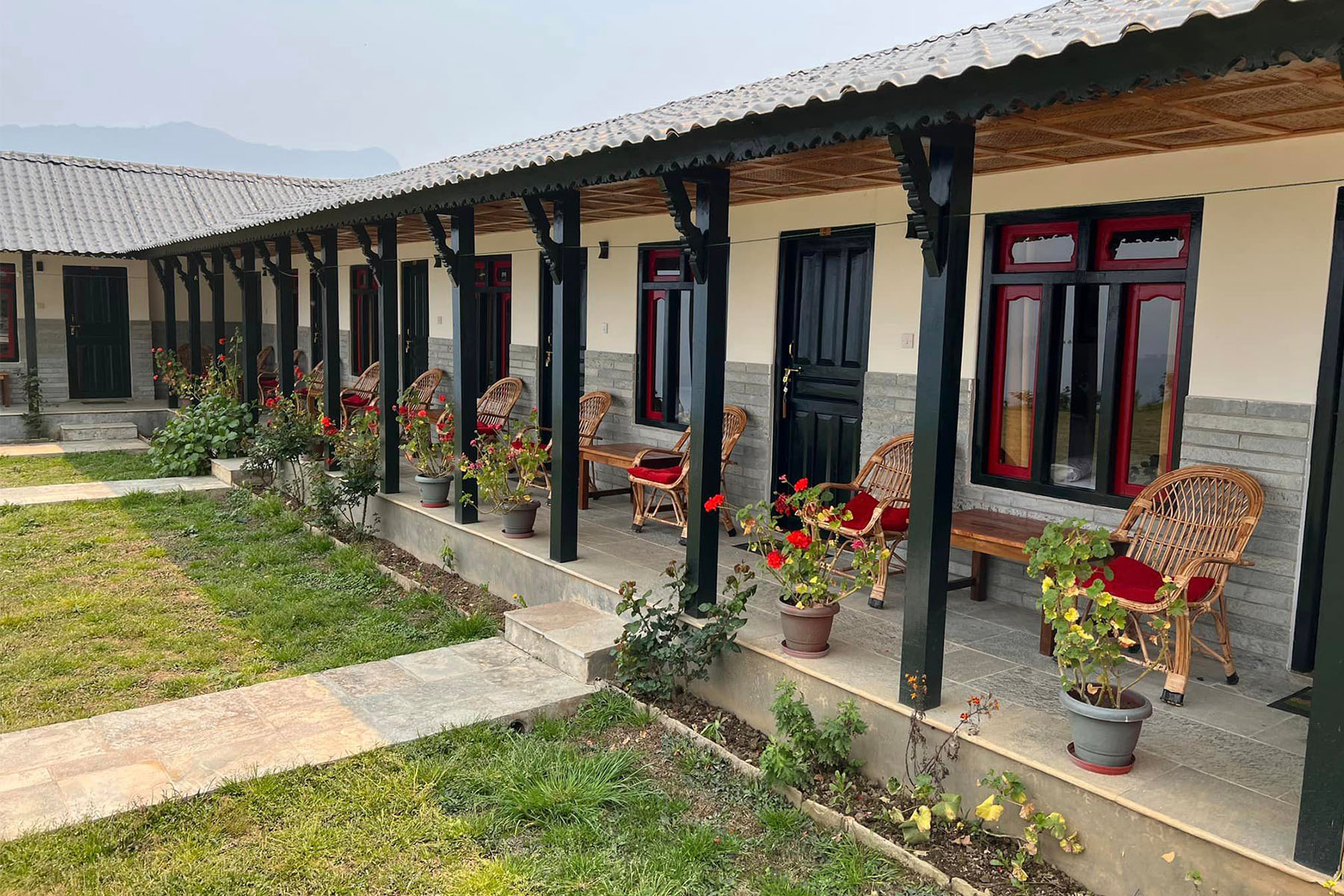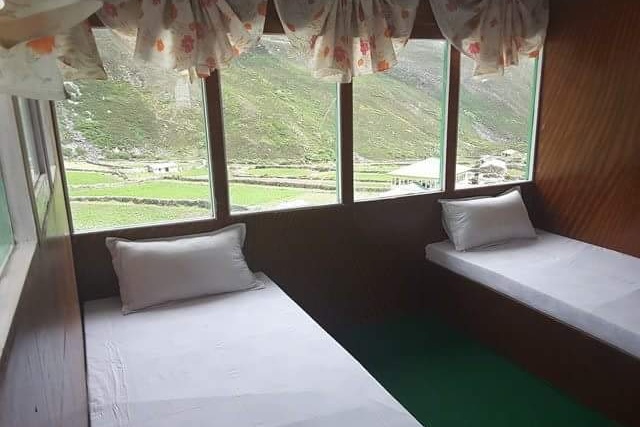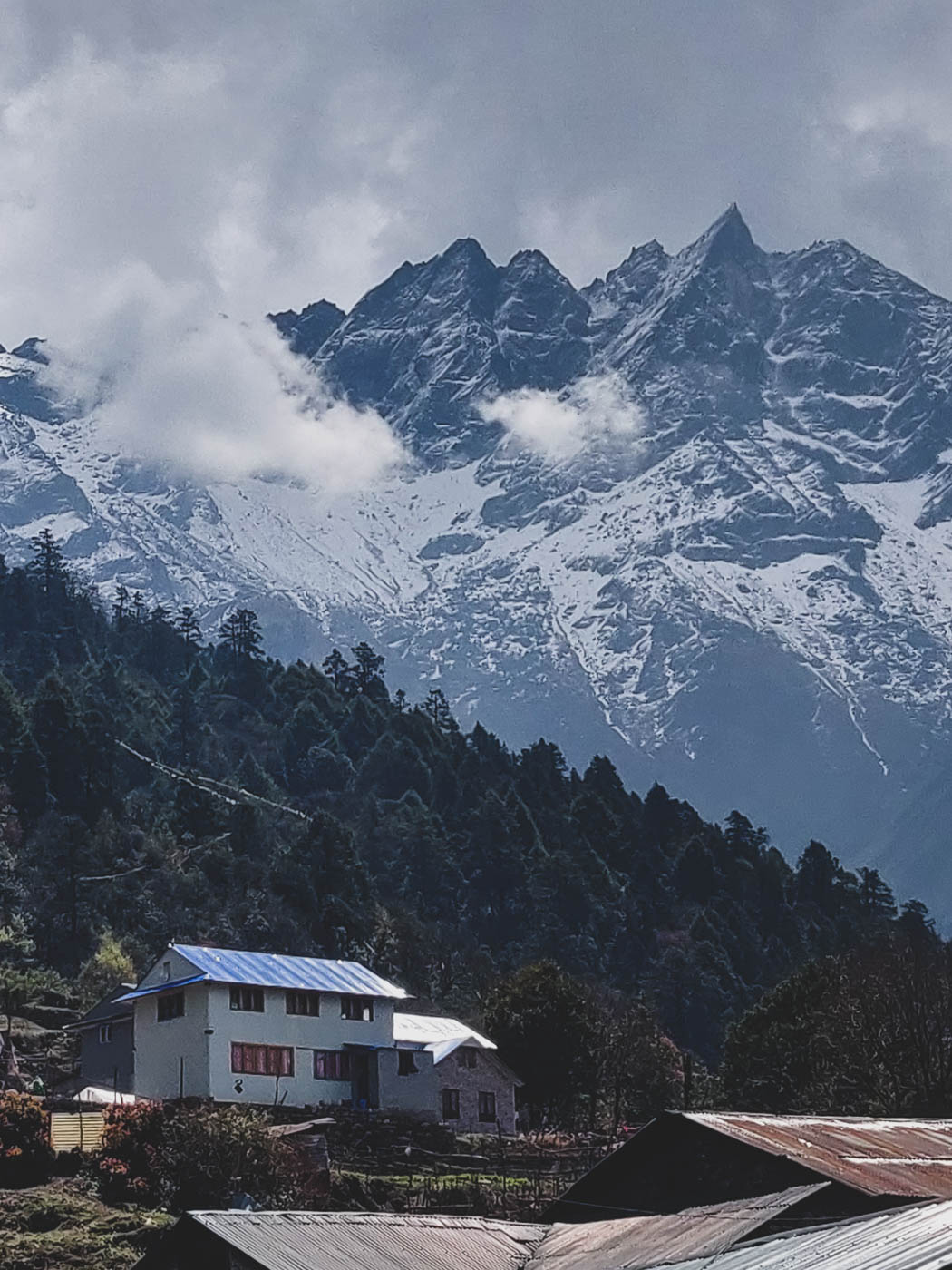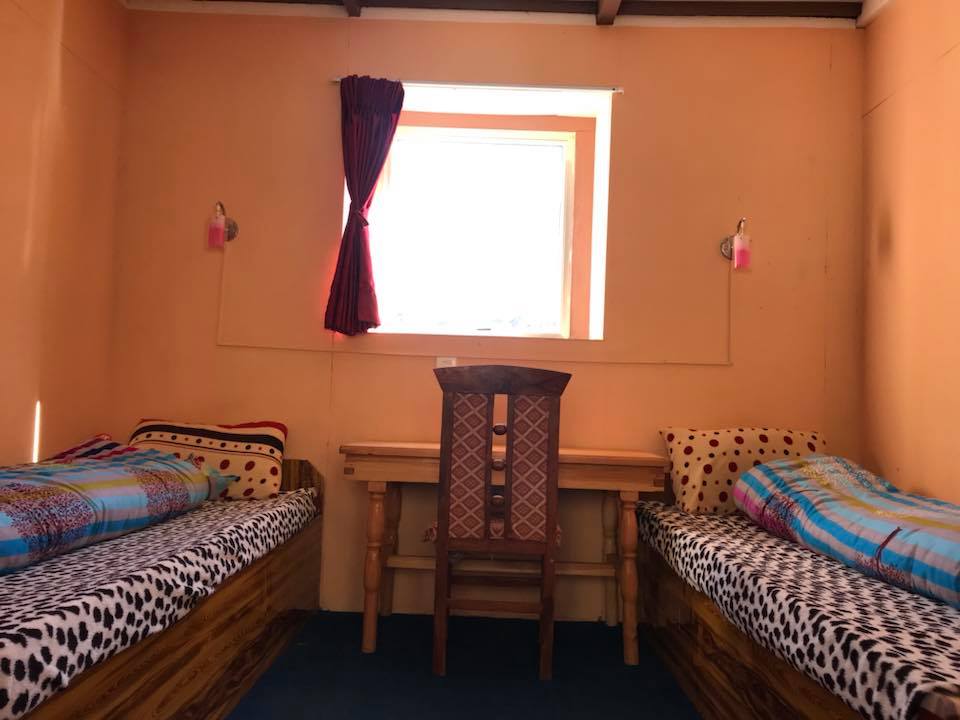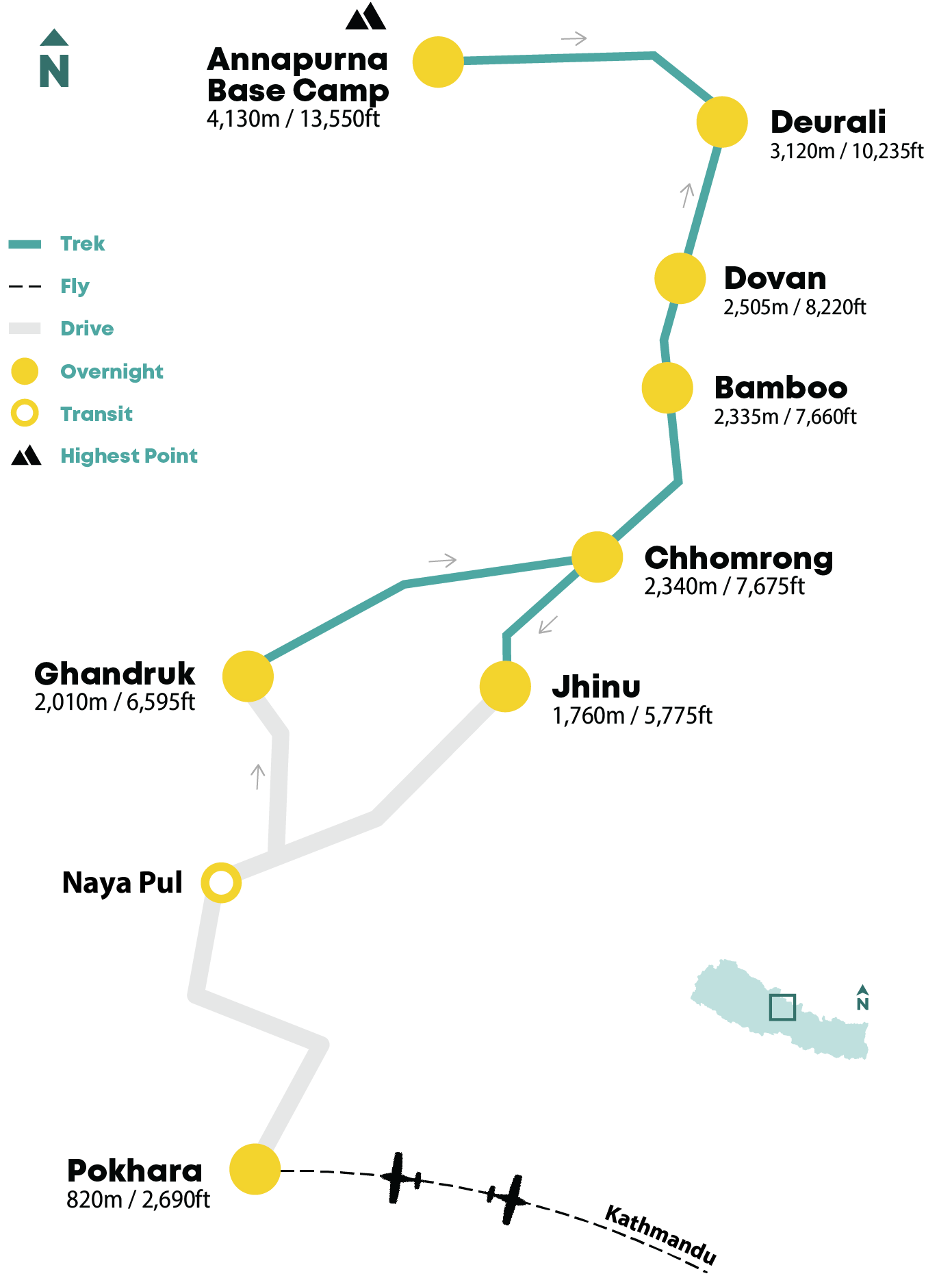|
Mountain Trek / Annapurna Region / Nepal Annapurna Base Camp TrekNext tentative Date: Available as a Private Trek on a date of your preference.
Find yourself amidst grand Himalayan mountains on a trek that goes deep into the belly of Annapurna. |
Overview
The Annapurna Base Camp (ABC) Trek is one of Nepal’s most rewarding and scenic treks, offering a close-up view of some of the world’s highest and most iconic peaks. The trail takes you through lush rhododendron forests, terraced fields, and traditional Gurung and Magar villages, gradually ascending into the high Himalayas. Along the way, trekkers are treated to awe-inspiring views of peaks such as Machapuchare (Fishtail) – 6,993 m / 22,943 ft, Annapurna South – 7,219 m / 23,684 ft, Hiunchuli – 6,441 m / 21,122 ft, and Annapurna I – 8,091 m / 26,545 ft.
The trek culminates at Annapurna Base Camp (4,130 m / 13,550 ft), an alpine amphitheater surrounded by towering snow-capped giants. Sunrise and sunset from the base camp offer unforgettable panoramas, with the peaks glowing in golden light against a pristine sky. This trek is spectacular not only for its dramatic mountain scenery but also for its cultural richness, cozy teahouses, and the sense of accomplishment in reaching the heart of the Annapurna Massif—all without requiring technical climbing skills. It’s a perfect choice for both first-time trekkers and experienced adventurers seeking a classic Himalayan experience.
Highlights
| Find yourself in the shadows of the mightly Annapurnas, the eighth highest mountain in the world.. | |
| Witness the spectacular 360 degree views of the snow-capped mountains up close in a matter of a week. | |
| Experience the majestic sunrise from Annapurna Base Camp. | |
| Trek among the gorgeous rhododendron forest trails, pass stunning rivers and natural hot spring. | |
| Come across picturesque Gurung villages and tiny rural settlements. | |
| Rejuvenate in one of the finest accommodations in the lake city of Pokhara after the trek. |
If you want to find yourself surrounded by the mighty Himalayas in a short duration of time, Annapurna Base Camp Trek is for you! ABC trek is considered a moderate trek with a mix of steep and gradual ascents, not overly strenuous. The highest point of the trek is ABC (4,100m / 13,450ft). To minimize the risk of altitude sickness, we will maintain a slow and easy pace. On average, you can expect to walk for 4-6 hours each day. The trails are generally well-maintained; however, some sections may have rocky or uneven terrain, and there are areas prone to landslides, especially as you ascend closer to the base camp.
Due to restrictions imposed by local authorities, the number of hotels operating in the region is limited, resulting in basic accommodation facilities along the way to the base camp. As you ascend to higher altitudes, it is likely that you will stay in dormitory-style rooms with 6 to 7 beds. Rest assured, you will be accompanied by experienced guides and porters who will carry your luggage during the trek, ensuring safety and providing you with a great experience.
Best time to go
JanFebMarAprMayJunJulAugSepOctNovDec
JanFebMarAprMayJun
JulAugSepOctNovDec
| Group Sizepax | Fixed Departureprices per person | Regularprices per person |
| 2 - 3 | USD 1100 | |
| 4 - 7 | USD 950 | |
| 8 & up | USD 875 |
|
|
|
|
|
Prices valid until Dec 31st, 2026
Prices for expats is less by USD 75
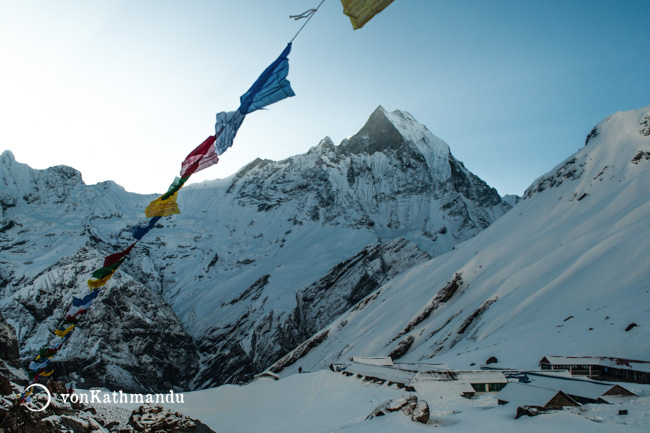
Annapurna Base Camp after a night of snowfall
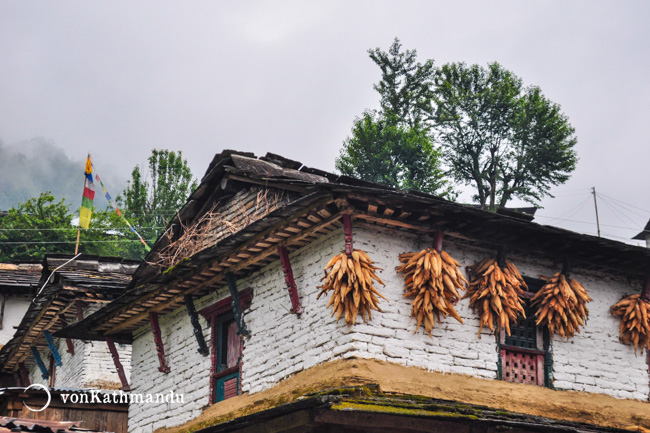
Maize left for drying on a traditional Gurung house
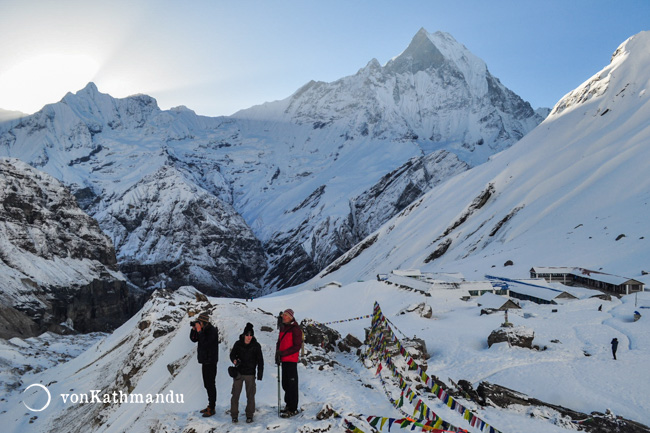
Macchapuchare seen from Annapurna Base Camp
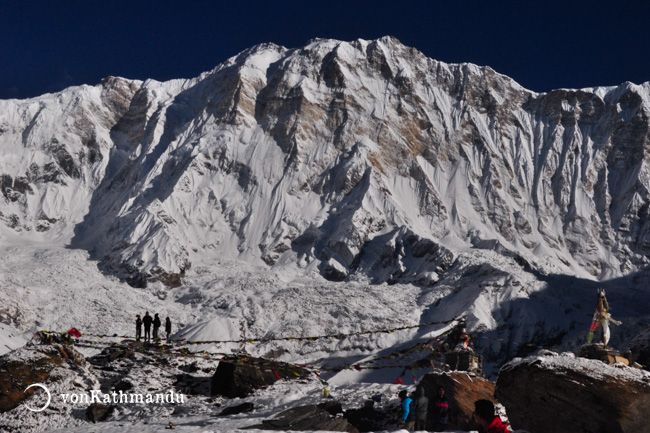
Imposing massif of Annapurna I stands at 8091m above sea level
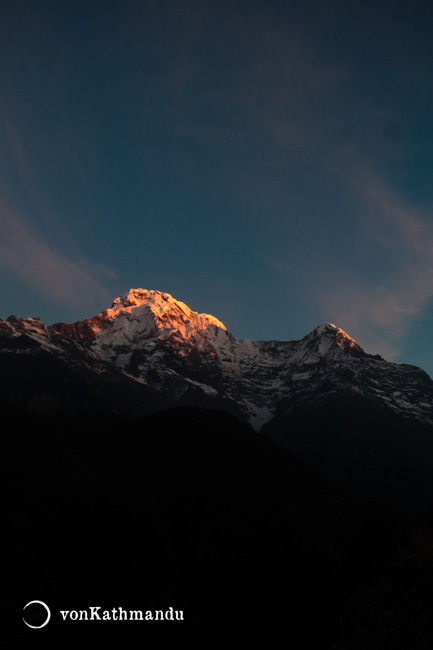
Annapurna South and Hiuchuli as observed from Ghandruk
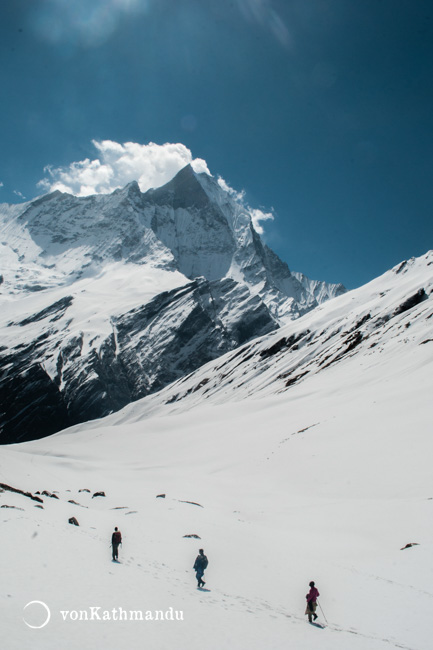
Machhapuchare mountain
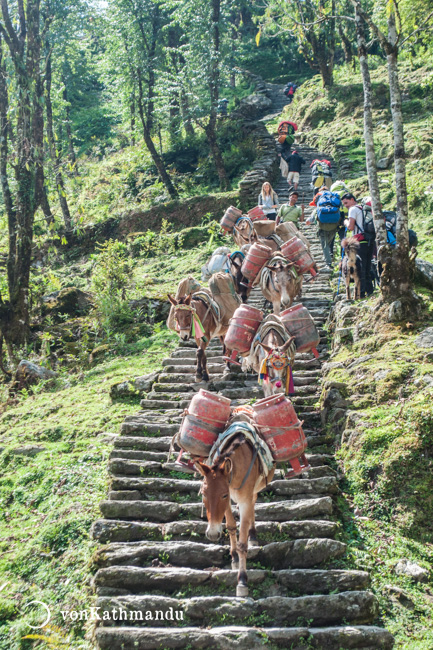
The preferred beast of burden on ABC trails are mules and donkeys
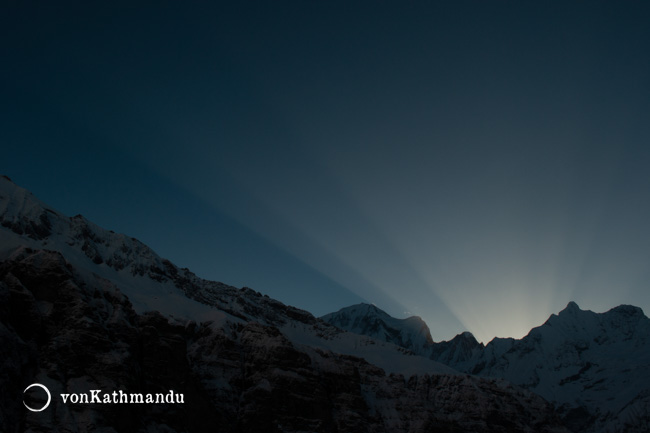
Bursts of morning rays over Annapurna
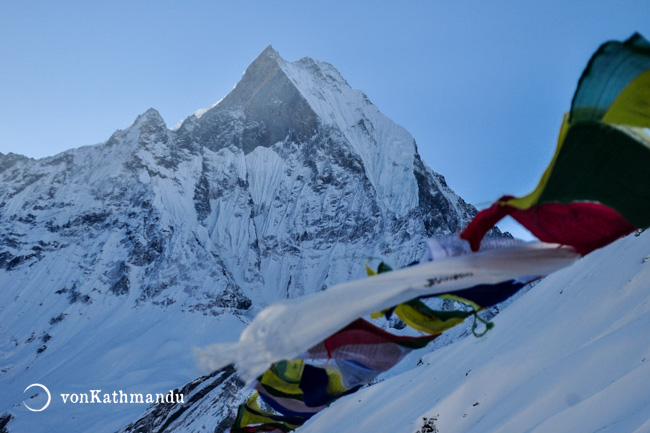
Fishtail Mountain with fresh snow
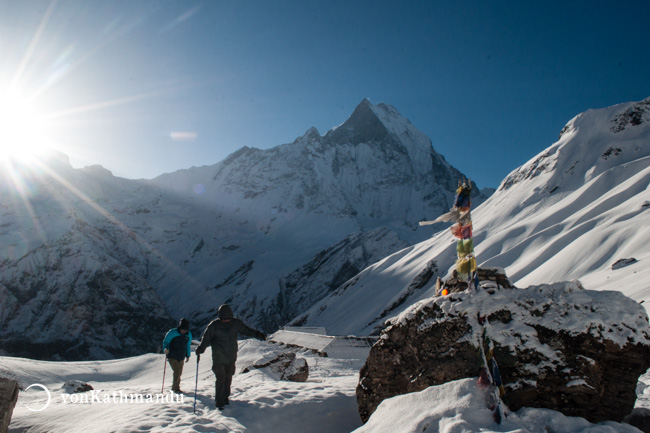
Trekkers make their way to a viewpoint near ABC
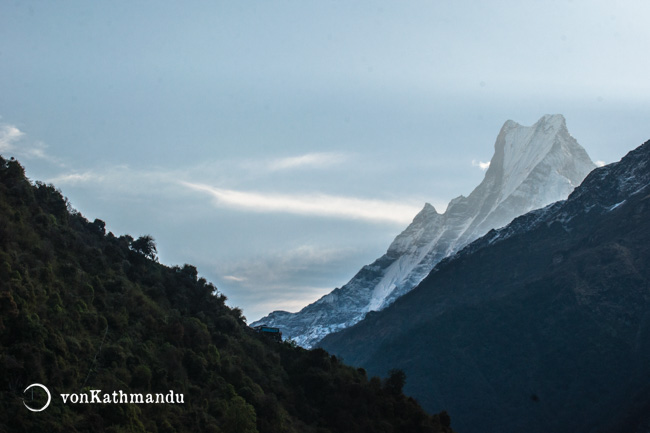
The classic double peak of Machhapuchare seen from Sinuwa
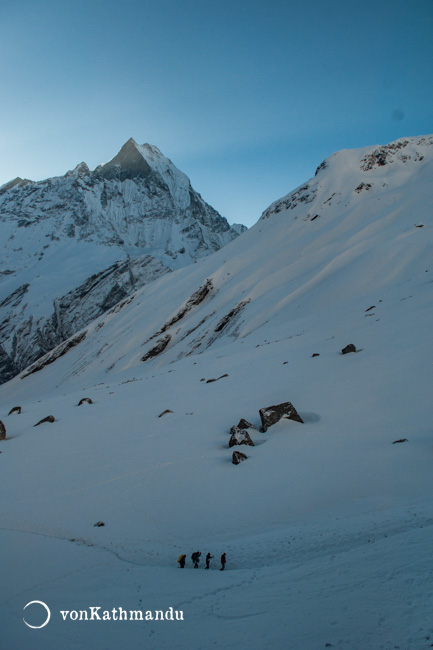
Snowy trails to Annapurna Base Camp
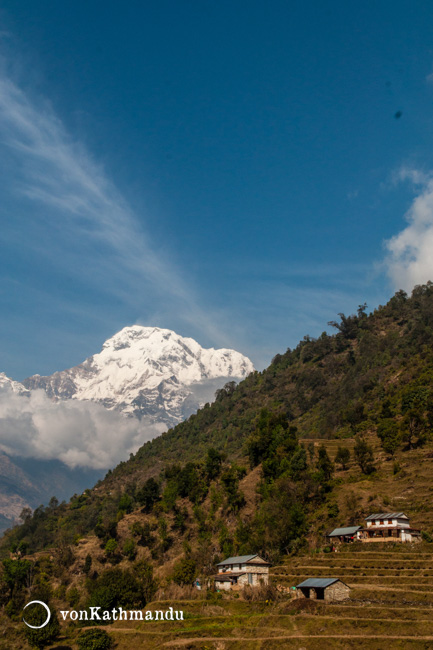
Tiny serene hamlets dot the trail
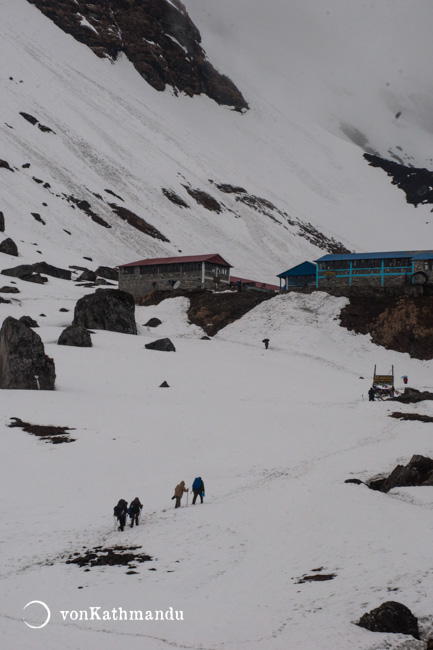
After days of walking, the sight of ABC is quite a relief
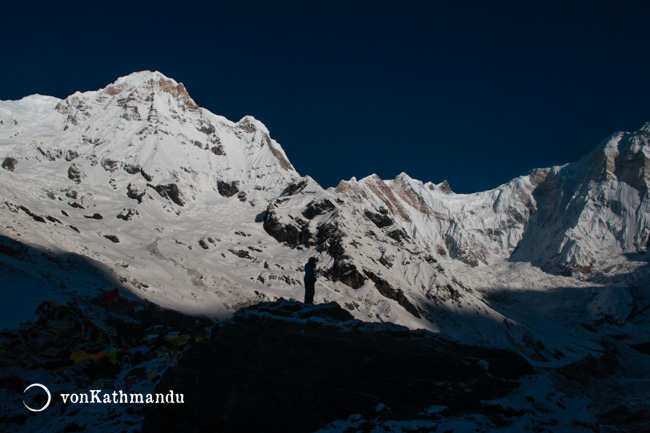
Silhouetted against glistening Annapurnas
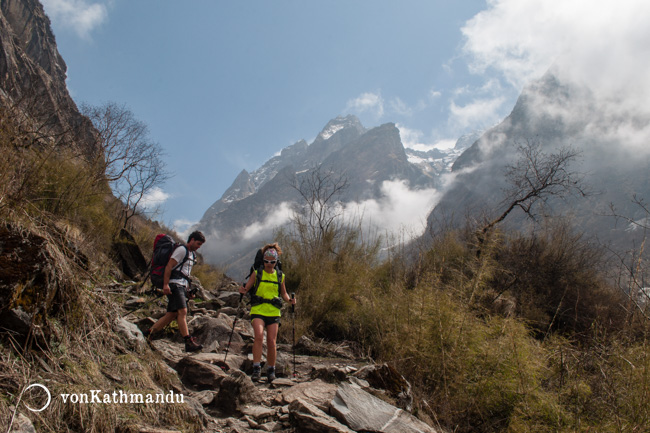
Heading back down to civilization from Annapurna Base Camp
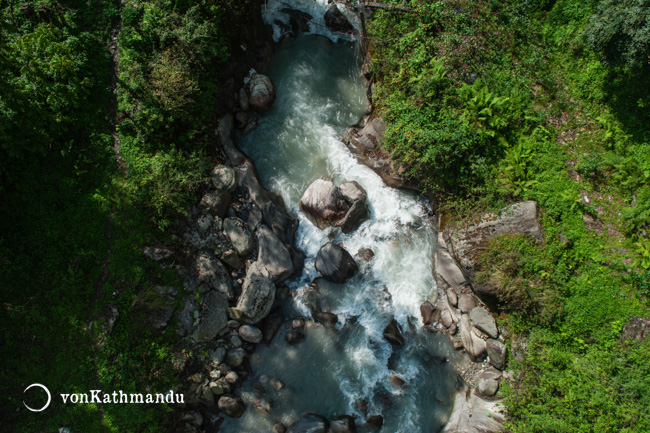
Modi River is fed by the the glaciers of Annapurna
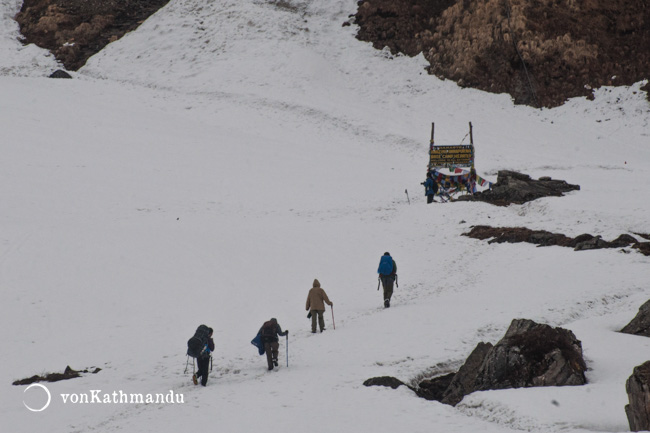
Final steps before reaching Annapurna Base Camp
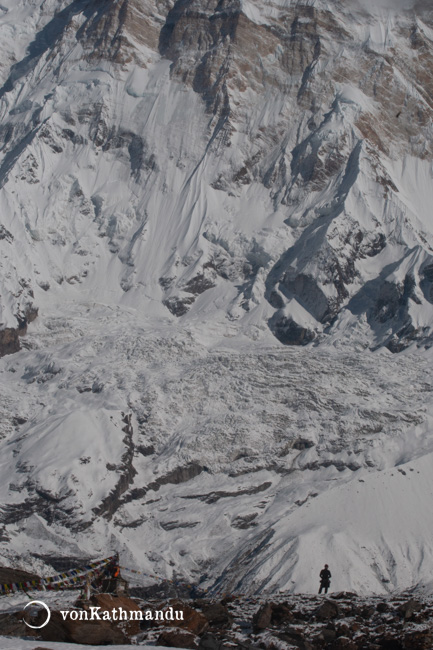
Strain your neck to see the full might of the mountains
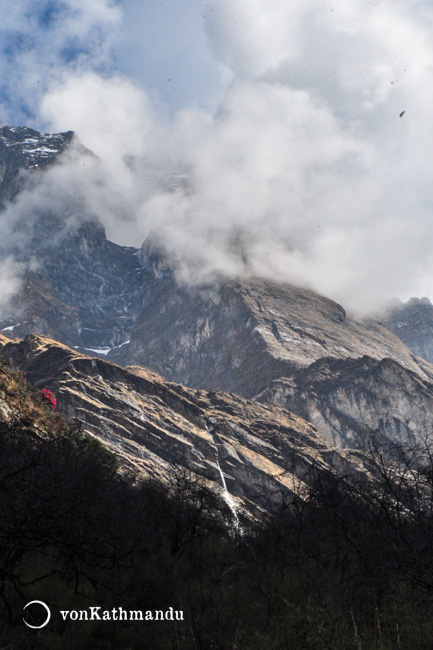
Countless waterfalls gushing down from high massifs of Hiuchuli and Machhapuchare are a sight to behold
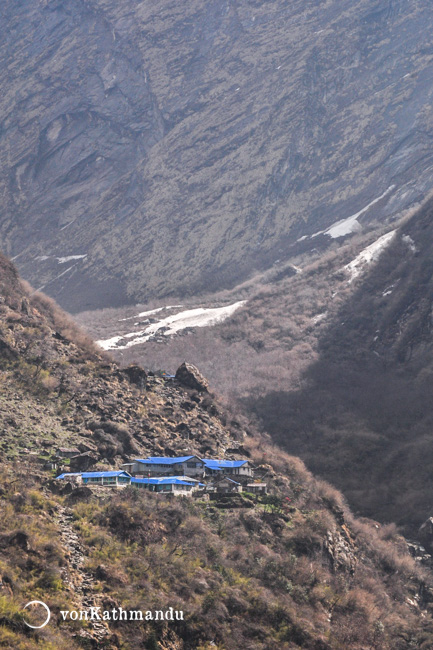
Tucked away in the nooks of Annapurna Valley, Sinuwa is a small settlement with great views of Fishtail
Itinerary
|
Day 1 |
Kathmandu - Pokhara - Ghandruk |
|
|
Day 2 |
Ghandruk - Chhomrong |
|
|
Day 3 |
Chhomrong - Dovan |
|
|
Day 4 |
Dovan - Deurali |
|
|
Day 5 |
Dovan - Annapurna Base Camp (ABC) |
|
|
Day 6 |
Annapurna Base Camp (ABC) - Bamboo |
|
|
Day 7 |
Bamboo - Jhinu |
|
|
Day 8 |
Jhinu - Pokhara - Kathmandu |
|
|
Day 1 |
Kathmandu - Pokhara - Ghandruk |
|
|
Fly from Kathmandu to Pokhara 30 mins In the morning, we take a scenic flight from Kathmandu to the gorgeous Pokhara city that sits by Phewa Lake and is dwarfed by the Annapurna range. |
|
|
Drive from Pokhara to Ghandruk 2 to 2.5 hrs We drive to Lakeside and take a lovely morning stroll by the Phewa lake. After breakfast, our vehicle drives us through the Pokhara-Baglung highway. We leave the highway from Nayapul and drive to Ghandruk – a large Gurung settlement. Expect some bumps on the roads. |
|
|
Explore Ghandruk Gurung is an ethnicity of Nepal, with their own culture, dialect and lifestyle. Treat yourself some lazy time over lunch gazing at the mountains or explore the town and visit the Gurung museum if you wish to. |
Meals Included: Breakfast
Accommodation: Snowland Lodge Ghandruk
|
Day 2 |
Ghandruk - Chhomrong |
|
|
Trek from Ghandruk to Chhomrong 5 to 6 hrs This trail descends gently from the traditional Gurung village of Ghandruk through terraced fields and forested paths. You’ll pass small streams, stone-paved trails, and lush rhododendron and oak forests. As you approach Chhomrong, the landscape changes to steep cliffs with views of Annapurna South, Hiunchuli, and Machapuchare. This section provides an immersive introduction to the Annapurna region’s natural beauty and local culture. |
Meals Included: Breakfast
Accommodation: Mountain Lodge
|
Day 3 |
Chhomrong - Dovan |
|
|
Trek from Chhomrong to Dovan 6 to 7 hrs From Chhomrong, the trail initially descends to cross the Chhomrong Khola, then begins a steady climb through dense bamboo and rhododendron forests. The path winds alongside waterfalls and river gorges, offering glimpses of the surrounding peaks. The trek to Dovan (2,600 m / 8,530 ft) is moderate but scenic, passing through terraced villages and alpine landscapes, with opportunities to spot local wildlife along the way. |
Meals Included: Breakfast
Accommodation: Mountain Lodge
|
Day 4 |
Dovan - Deurali |
|
|
Trek from Dovan to Deurali 5 to 6 hrs The trail from Dovan to Deurali becomes steeper as you enter higher alpine terrain. You’ll trek through oak and rhododendron forests that gradually give way to rocky ridges and bamboo thickets. The path offers spectacular views of Machapuchare and the Annapurna peaks. This section is more challenging due to elevation gain but rewards trekkers with pristine mountain scenery and fewer crowds. |
Meals Included: Breakfast
Accommodation: Mountain Lodge
|
Day 5 |
Dovan - Annapurna Base Camp (ABC) |
|
|
Trek from Dovan to Annapurna Base Camp 5 to 6 hrs From Deurali, the final trail to Annapurna Base Camp traverses dramatic landscapes of moraine, glaciers, and alpine meadows. The path offers panoramic views of Annapurna South (7,219 m / 23,684 ft), Hiunchuli (6,441 m / 21,122 ft), and Machapuchare (6,993 m / 22,943 ft) as you ascend. The last few kilometers bring you to the iconic amphitheater of ABC, surrounded by towering snow-capped peaks—a breathtaking reward for the trekker. |
Meals Included: Breakfast
Accommodation: Mountain Lodge
|
Day 6 |
Annapurna Base Camp (ABC) - Bamboo |
|
|
Trek from Annapurna Base Camp to Bamboo 7 to 8 hrs The descent from Annapurna Base Camp to Bamboo is gradual but long, taking you back through alpine meadows, rocky ridges, and scattered pine forests. The trail retraces parts of the ascent, with sweeping views of Annapurna South, Hiunchuli, and Machapuchare along the way. This section allows trekkers to savor the Himalayan panorama from a new perspective and enjoy the serene beauty of the mountains as you descend into lower altitudes. |
Meals Included: Breakfast
Accommodation: Mountain Lodge
|
Day 7 |
Bamboo - Jhinu |
|
|
Trek from Bamboo to Jhinu 5 to 6 hrs From Bamboo, the trail continues descending through dense forests of oak and rhododendron, terraced farmland, and small villages. You’ll cross streams and charming wooden bridges, soaking in the tranquil rural landscapes. Arriving at Jhinu, the pace slows and the environment becomes warmer and more tropical as you near the subtropical lower valleys. |
|
|
Explore the Natural Hot Springs at Jhinu (Optional) 2 to 3 hrs Take a side hike of around 30 from the main trail or village area to Jhinu's natural hot springs amid the beautiful riverside setting. Take time to relax in the warm, mineral-rich waters—a perfect reward after days of trekking. |
Meals Included: Breakfast
Accommodation: Mountain Lodge
|
Day 8 |
Jhinu - Pokhara - Kathmandu |
|
|
Trek from Jhinu to roadhead 1 hr We hike for about an hour to reach the road head, where we will catch the jeep back to Pokhara. |
|
|
Drive from Jhinu to Pokhara 2.5 to 3 hrs The drive from Jhinu to Pokhara winds through lush valleys, rivers, and rural villages, offering glimpses of local life in the Annapurna region. As you descend from the hills to the lakeside city, you’ll be greeted by views of the Fewa Lake and the surrounding Annapurna peaks. |
|
|
Fly from Pokhara to Kathmandu 30 mins A short but scenic flight back to Kathmandu watching the mountains you saw up close during the trek. |
Meals Included: Breakfast
Snowland Lodge Ghandruk |
X Close Accommodation Popup
X Close Popup
Ghandruk, Annapurna, Nepal
Room Amenities
| • | Free Wi-Fi | • | Room Service | • | Private Bathroom | • | Hot Shower | • | Towels | • | Slippers | • | Power Socket | • | Daily Housekeeping |
Property Amenities
| • | Restaurant and Bar | • | Garden | • | Outdoor Seating | • | Mountain Views |
Mountain Lodge |
X Close Accommodation Popup
X Close Popup
Nepal
Mountain lodges are the basic accommodation set up by locals to cater to trekkers in the trails. The common features across all lodges are standard rooms, a spacious and heated dining hall, and a restaurant with a menu. The rooms in mountain lodges generally have two or three twin beds with a mattress and blanket. If you are used to sleeping warm, we highly recommend bringing your own sleeping bag and liner. Other amenities could be a table, hanger, and dustbin but do not expect to have charging ports and attached toilets in the rooms. Moreover, it is mandatory to have meals in the facility you’re staying at.
Room Amenities
| • | Shared Toilet |
Property Amenities
| • | Restaurant and Bar | • | Outdoor Seating | • | Mountain Views |
Mountain Lodge |
X Close Accommodation Popup
X Close Popup
Nepal
Mountain lodges are the basic accommodation set up by locals to cater to trekkers in the trails. The common features across all lodges are standard rooms, a spacious and heated dining hall, and a restaurant with a menu. The rooms in mountain lodges generally have two or three twin beds with a mattress and blanket. If you are used to sleeping warm, we highly recommend bringing your own sleeping bag and liner. Other amenities could be a table, hanger, and dustbin but do not expect to have charging ports and attached toilets in the rooms. Moreover, it is mandatory to have meals in the facility you’re staying at.
Room Amenities
| • | Shared Toilet |
Property Amenities
| • | Restaurant and Bar | • | Outdoor Seating | • | Mountain Views |
Mountain Lodge |
X Close Accommodation Popup
X Close Popup
Nepal
Mountain lodges are the basic accommodation set up by locals to cater to trekkers in the trails. The common features across all lodges are standard rooms, a spacious and heated dining hall, and a restaurant with a menu. The rooms in mountain lodges generally have two or three twin beds with a mattress and blanket. If you are used to sleeping warm, we highly recommend bringing your own sleeping bag and liner. Other amenities could be a table, hanger, and dustbin but do not expect to have charging ports and attached toilets in the rooms. Moreover, it is mandatory to have meals in the facility you’re staying at.
Room Amenities
| • | Shared Toilet |
Property Amenities
| • | Restaurant and Bar | • | Outdoor Seating | • | Mountain Views |
Mountain Lodge |
X Close Accommodation Popup
X Close Popup
Nepal
Mountain lodges are the basic accommodation set up by locals to cater to trekkers in the trails. The common features across all lodges are standard rooms, a spacious and heated dining hall, and a restaurant with a menu. The rooms in mountain lodges generally have two or three twin beds with a mattress and blanket. If you are used to sleeping warm, we highly recommend bringing your own sleeping bag and liner. Other amenities could be a table, hanger, and dustbin but do not expect to have charging ports and attached toilets in the rooms. Moreover, it is mandatory to have meals in the facility you’re staying at.
Room Amenities
| • | Shared Toilet |
Property Amenities
| • | Restaurant and Bar | • | Outdoor Seating | • | Mountain Views |
Mountain Lodge |
X Close Accommodation Popup
X Close Popup
Nepal
Mountain lodges are the basic accommodation set up by locals to cater to trekkers in the trails. The common features across all lodges are standard rooms, a spacious and heated dining hall, and a restaurant with a menu. The rooms in mountain lodges generally have two or three twin beds with a mattress and blanket. If you are used to sleeping warm, we highly recommend bringing your own sleeping bag and liner. Other amenities could be a table, hanger, and dustbin but do not expect to have charging ports and attached toilets in the rooms. Moreover, it is mandatory to have meals in the facility you’re staying at.
Room Amenities
| • | Shared Toilet |
Property Amenities
| • | Restaurant and Bar | • | Outdoor Seating | • | Mountain Views |
Mountain Lodge |
X Close Accommodation Popup
X Close Popup
Nepal
Mountain lodges are the basic accommodation set up by locals to cater to trekkers in the trails. The common features across all lodges are standard rooms, a spacious and heated dining hall, and a restaurant with a menu. The rooms in mountain lodges generally have two or three twin beds with a mattress and blanket. If you are used to sleeping warm, we highly recommend bringing your own sleeping bag and liner. Other amenities could be a table, hanger, and dustbin but do not expect to have charging ports and attached toilets in the rooms. Moreover, it is mandatory to have meals in the facility you’re staying at.
Room Amenities
| • | Shared Toilet |
Property Amenities
| • | Restaurant and Bar | • | Outdoor Seating | • | Mountain Views |
Customize this trip
Take a heli back.
For those short on time or looking to add an exhilarating experience of flying over the majestic Himalayas, you have the option to charter a private helicopter on the way down. Inquire for prices and options!
Kathmandu Hotel and Transfers
-
If you’d like us to organize airport transfers and arrange your stay in Kathmandu or any other cities, let us know. We’re happy to give you options based on your preference, and book them for you.
Here’s one of our popular 2 days add-on: USD 185 per person:
- Airport pick up and drop off, facilitated by an English-speaking representative
- 2 nights in a four-star hotel in Kathmandu (Hotel Shankar or similar) on bed & breakfast plan and twin-sharing basis
